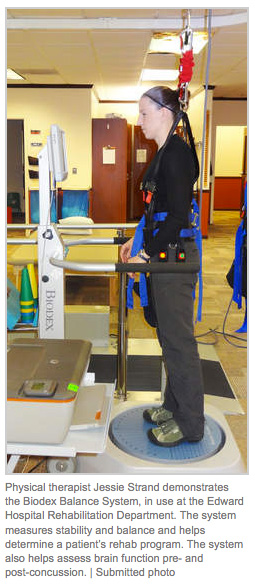- Physical Medicine Home
- Products
- Programs
- Applications
- Find a Clinic
- Blog
- Events
- Education & Training
- In The News
- Press Releases
In The News
< back to resultsRehab Equipment Gets Patients Back on Track
May 13, 2013, 4:00am
 Bolingbrook resident Richard Bonham, 72, was enjoying his retirement, including working on projects at his home workbench. But his comfortable routine was interrupted on March 17, 2012, when a stroke impaired his ability to walk, the use of his left arm and his vision. He also suffered several fractured bones during subsequent falls.
Bolingbrook resident Richard Bonham, 72, was enjoying his retirement, including working on projects at his home workbench. But his comfortable routine was interrupted on March 17, 2012, when a stroke impaired his ability to walk, the use of his left arm and his vision. He also suffered several fractured bones during subsequent falls.
After stints as an inpatient at a couple of rehabilitation facilities, Bonham continued his rehab in October as an outpatient at Edward Hospital.
“Happily, my vision had vastly improved, but I had to learn to walk again,” he said.
Bonham’s timing was good – Edward’s Rehabilitation Department had just installed new state-of-the-art equipment to help patients with mobility and balance issues.
“We’re one of the few area hospitals with a partial body weight support system to help patients re-learn to walk,” according to Karen Granato, PT, ATC, OCS, Edward’s Director of Rehabilitation Services. “This involves hooking the patient into a harness suspended from a ceiling track, which runs over the treadmill and around the room. The therapist controls how much weight the patient needs to bear, making it easier to walk.”
“I had developed a real fear of falling,” said Bonham. “This equipment doesn’t allow you to fall. I felt like I was safe and could do what I needed to do.”
Bonham used this system in conjunction with another piece of new equipment – the Biodex Balance System. This consists of a computerized platform that measures the patient’s ability to balance, and a control panel that provides feedback. The system measures the patient’s stability when they move to the front, the back, or side to side,” said Edward physical therapist Jen Frederick-Arcuri, PT, MPT. “We can then specifically direct their movements to help them overcome any deficits.”
Frederick-Arcuri said the therapy brought Bonham’s fall risk down from 100 percent to 70 percent. And he’s able to do simple tasks that require balance, such as picking up something off the floor.
Bonham now undergoes occupational therapy, which focuses on the use of his left hand and arm. His occupational therapist, Jen Matern, OTR/L, says she was impressed that one of Bonham’s priorities was to get back to his share of kitchen tasks – especially loading the dishwasher.
Initially, pain and spasms kept Bonham from tolerating much rehabilitation of his hand, so Matern referred him back to his neurologist at the Edward Neurosciences Institute, Mohammed Sajed, M.D. Sajed began periodic Botox injections that relieve the pain and relax the muscles, allowing Matern to do more aggressive therapy.
“One goal was to get Richard back to his workbench,” said Matern. “We did repetitive tasks, such as picking up nuts and bolts and working with pegs. He’s able to do those things now. Part of his success is his wonderful attitude. He says he isn’t going to ‘try’ to do something, he’s going to do it. And he does.”
“I’m getting better. It’s the small victories, like being able to use a zipper, that mean a lot,” said Bonham. “And it really helps to have support like I have from my wife, Betty, who helps me with my exercises and medications. Not everyone is so lucky.”
You can learn more at “Be StrokeAware,” Thursday, May 23, 7 p.m. in the Education Center at Edward Hospital, 801 S. Washington St. in Naperville. Neurologists from the Edward Neurosciences Institute will offer lifesaving tips and breakthrough techniques to prevent and treat stroke. To register, call (630) 527-6363.
For more information, visit www.edward.org/rehab or call (630) 527-3375.



